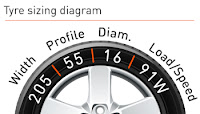Today we will discuss the common tyre problems faced by the
motorists. As the tyre costs are high and second to only fuel cost, it needs to
be taken care of. This guide will enable you to spot out the fault and get it
corrected at the instant so as to avoid potential problems caused by tyre
failure. There are some common tyre faults/defects/problems discussed as under:
· Overinflation:
In this condition the tyre is inflated more than recommended tyre pressure by
the manufacturer. There is a common belief that more load can be carried on
more air pressure and that it increases the load bearing capacity of the tyre. Actually,
it’s the other way around. Over inflated tyres are like overinflated balloons
and are more prone to cuts and damages. This condition normally wears out the centre
of the tyre and will shorten its life.
·
Underinflation:
This is the condition in which the pressure is less than the recommended
pressure by the manufacturer. Too little pressure in the tyre results in the
blowing up of tyres as a result of the heat build-up. It also results in
punctures, putting load on the steering, delayed or less responsive car
reaction. Extended braking time etc. The other visible effect of underflation
is rapid shoulder wear, which means the shoulders of tyre are in constant touch
to the road, more than the centre of tyre.
·
Cracking:
Too much heat or too much cold weakens the
tyre and develops cracks on the tyre making it unserviceable.
Age
makes the tyre brittle and it begins to crack as it gets old.
Too much air or too little air inflation
also makes the tyre to crack with time.
·
Abnormal
wear and tear: The motorist has to keep an eye on the tyres for any
kind of an abnormal wear. The abnormal wear reduces the life of the tyre
drastically and may even result in accidents or create potential problems to
the motorist. This condition could be a result of misalignment, if there is an
uneven wear on the front tyres or the rear tyres or if the car is pulling to
one side. The alignment has to be done for correction of this defect.
·
Cuts
or other damages resulting in punctures: Cuts or punctures or any other
kind of damage results in tyre damage if the vehicle is not stopped in time to
avoid it being run flat. The deflation could be caused because of a leaking
valve, punctures, damaged wheel allowing the air to leak resulting in tyre deflation,
old tyres unable to hold air not sealing the tyre with the rim and allowing the
air to leak and deflate the tyre resulting in tyre damage.
Hope this article is of help to the
people who are not aware of the common tyre problems, Please let me know if you
have any questions or queries on the above topic. You can also let me know the
next topic to be discussed.


